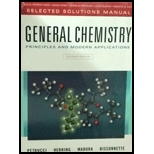
Concept explainers
(a)
Interpretation:
Identify the compound with higher boiling point out of
Concept introduction:
Boiling point is the temperature at which the liquid starts boiling. At this temperature the vapor pressure of liquid becomes equal to the atmospheric pressure. Boiling point of any substance depends on the structure, molecular weight and branching on the parent carbon chain of compound. As the branching on side chain increases, the boiling point decreases whereas it is increases with increasing the molecular mass of the substance. The presence of intermolecular force of attraction between molecules also effects the boiling point. If the molecules will strongly bonded with each other, the boiling point of it will be higher than the molecules with weak intermolecular force of attraction.
(b)
Interpretation:
Identify the compound with greater solubility in water out of
Concept introduction:
Alcohols are usually in water due to presence of polar −OH group. The presence of polar group in the molecule makes them soluble in polar solvents like water. Another reason of solubility of alcohols is the presence of hydrogen bonds between water and −OH group of alcohols. Since alcohols can form hydrogen bonding with water molecules therefore it increases the intermolecular force of attraction between molecules. That increases the solubility of alcohols.
(c)
Interpretation:
Identify the compound with greater acidity in aqueous solution out of
Concept introduction:
The ions formed in aqueous solution of carboxylic acid are called as carboxylate ions and hydronium ion.
Want to see the full answer?
Check out a sample textbook solution
Chapter 26 Solutions
Selected Solutions Manual For General Chemistry: Principles And Modern Applications
- Some of the physical properties of H2O and D2O are as follows: Property H2O D2O Density at 20C (g/ml) 0.997 1.108 Boiling point (C) 100.00 101.41 Melting point (C) 0.00 3.79 Hvap(kJ/mol) 40.7 41.61 Hfus (kJ/mol) 6.02 6.3 Account for the differences. (Note: D is a symbol often used for 2H, the deuterium isotope of hydrogen.)arrow_forwardWhich compound below would you most appropriately call hydrophobic? a. CH4 b. H2CO c. HCl d. NaClarrow_forwardPolymers do not crystallise easily because:a) they are long chain moleculesb) they contain covalent bondsc) the molecules are interconnected with H-bondingarrow_forward
- Choose the substance with the lowest boiling point and explain why -H2O -NaCl -CH4 -O3arrow_forwardWhich one of the following substances would be the most soluble in CCl4? HF I2 Li2O C6H14 CH3COOHarrow_forwardRearrange the in order of lowest - highest boiling point Ch3COOH, (CH3)2C=O, CH3CH2CH2CH3arrow_forward
- Proteins are chains of amino acids that can form in a variety of arrangements, one of which is a helix. What kind of IMF is responsible for holding the protein strand in this shape? On the protein image, show the locations of the ¡MFs that hold the protein together:arrow_forwardWhich substance, A or B, has the lower polarizability? A= CH3CH2CH3 B= CH3CH3arrow_forwardHow, In a cis isomer, the two bond dipoles reinforce each other ?arrow_forward
 Chemistry: Principles and ReactionsChemistryISBN:9781305079373Author:William L. Masterton, Cecile N. HurleyPublisher:Cengage Learning
Chemistry: Principles and ReactionsChemistryISBN:9781305079373Author:William L. Masterton, Cecile N. HurleyPublisher:Cengage Learning Chemistry & Chemical ReactivityChemistryISBN:9781133949640Author:John C. Kotz, Paul M. Treichel, John Townsend, David TreichelPublisher:Cengage Learning
Chemistry & Chemical ReactivityChemistryISBN:9781133949640Author:John C. Kotz, Paul M. Treichel, John Townsend, David TreichelPublisher:Cengage Learning Chemistry & Chemical ReactivityChemistryISBN:9781337399074Author:John C. Kotz, Paul M. Treichel, John Townsend, David TreichelPublisher:Cengage Learning
Chemistry & Chemical ReactivityChemistryISBN:9781337399074Author:John C. Kotz, Paul M. Treichel, John Townsend, David TreichelPublisher:Cengage Learning ChemistryChemistryISBN:9781305957404Author:Steven S. Zumdahl, Susan A. Zumdahl, Donald J. DeCostePublisher:Cengage Learning
ChemistryChemistryISBN:9781305957404Author:Steven S. Zumdahl, Susan A. Zumdahl, Donald J. DeCostePublisher:Cengage Learning
 Chemistry: An Atoms First ApproachChemistryISBN:9781305079243Author:Steven S. Zumdahl, Susan A. ZumdahlPublisher:Cengage Learning
Chemistry: An Atoms First ApproachChemistryISBN:9781305079243Author:Steven S. Zumdahl, Susan A. ZumdahlPublisher:Cengage Learning





